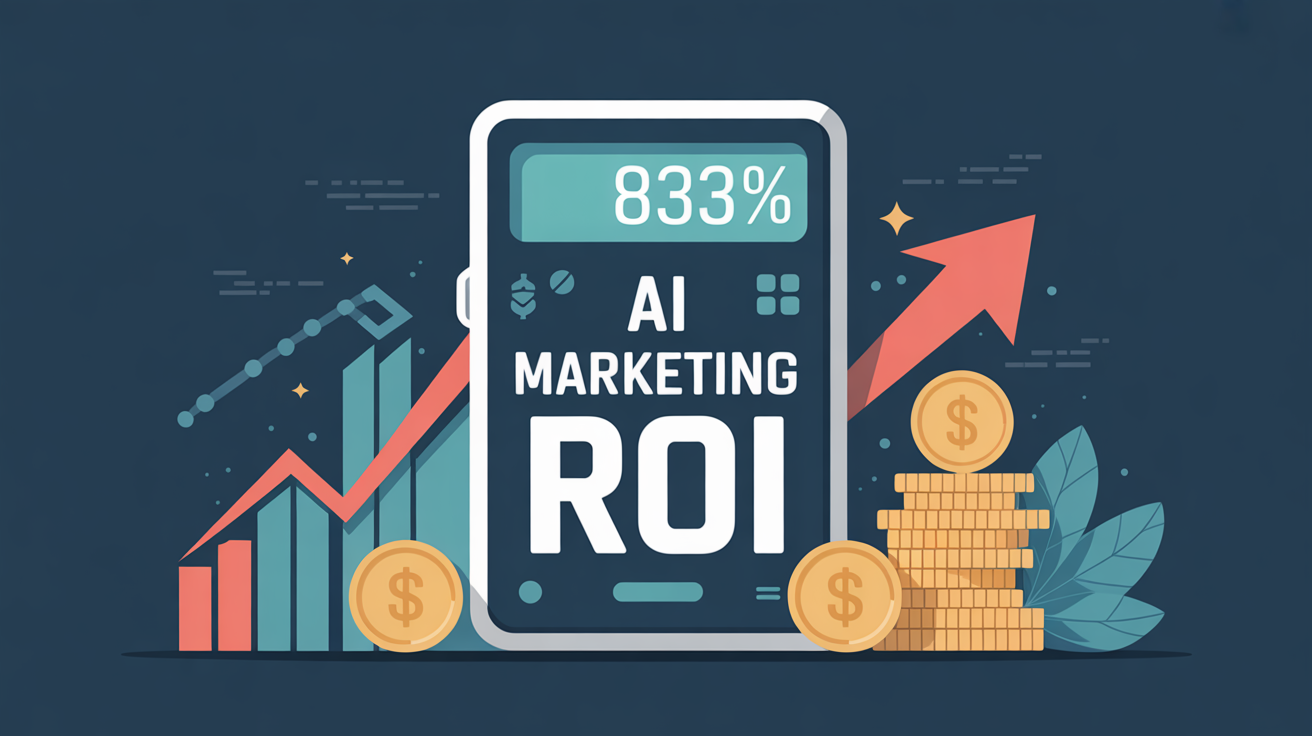How to calculate ROI for AI-powered marketing automation in an SMB
AI Systems • Jul 15, 2025 12:18:54 PM • Written by: Kelly Kranz

Calculating the Return on Investment (ROI) for AI marketing automation is straightforward. The core formula is: ROI = (Financial Gain − Investment Cost) ÷ Investment Cost. For SMBs, this translates to quantifying time saved, revenue generated, and subtracting the cost of the AI tools used.
This guide provides the precise formula, a practical example, and the key strategies to maximize your return by focusing on high-impact automation areas.
Frequently Asked Questions
What is the specific formula to calculate ROI for AI marketing automation?
The specific formula to calculate the return on investment for AI marketing automation is: ROI = ([Time Saved × Average Hourly Employee Cost] + Revenue Lift − AI Tool Cost) ÷ AI Tool Cost. This formula accounts for both efficiency gains from time saved and performance improvements from additional revenue generated.
What are the key areas to apply AI automation for the best ROI?
To maximize ROI, you should focus AI automation on three key areas: 1) Content Creation and Management, to reduce creation time and ensure brand consistency; 2) SEO and Ranking for the AI Search Era, to produce content at the scale needed to be cited by AI assistants; and 3) Personalized Email and Newsletter Campaigns, to increase engagement and conversion rates with tailored content.
How can an SMB effectively track and measure AI automation ROI?
To effectively track ROI, you must follow a three-step process. First, establish baselines by documenting current metrics like time spent on tasks and key performance indicators (KPIs) before implementation. Second, monitor the same KPIs after launching the AI system to measure improvements. Finally, use a centralized system to make tracking transparent and prove the value of time saved and assets generated.
Why is a customizable AI system often better for ROI than a standard SaaS tool?
A customizable AI system typically offers a better ROI for two main reasons. It is more cost-effective because you own the framework and only pay low, usage-based fees, which significantly reduces the 'AI Tool Cost' in the ROI formula. It is also more scalable and flexible, allowing you to instantly adapt to new AI models or changing business needs, an agility that packaged SaaS products cannot match.
The Core ROI Formula for AI Marketing Automation
To accurately measure the impact of AI on your marketing efforts, use this specific formula. It accounts for both efficiency gains (cost savings) and performance improvements (revenue lift).
ROI = ([Time Saved × Average Hourly Employee Cost] + Revenue Lift − AI Tool Cost) ÷ AI Tool Cost
Let's break down each component:
- Time Saved: The total number of hours your team saves per month by automating previously manual tasks.
- Average Hourly Employee Cost: The fully-loaded hourly rate of the employee(s) whose tasks are being automated. This should include salary, benefits, and overhead.
- Revenue Lift: The additional revenue generated from AI-driven activities. This can be attributed to improved lead generation, higher conversion rates, or increased customer lifetime value.
- AI Tool Cost: The total monthly or annual cost of the AI software, platforms, and API usage.
A Practical Example of AI ROI Calculation
Imagine an SMB's marketing manager, who costs the company $50/hour, spends 20 hours per month creating and scheduling social media content. They implement an AI automation system that costs $150/month.
- Pre-AI: 20 hours/month on content creation.
- Post-AI: The system reduces this to 2 hours of review and oversight.
- Time Saved: 18 hours per month.
- Cost Savings: 18 hours × $50/hour = $900.
- Revenue Lift: The consistent, higher-quality content generates two extra qualified leads per month, with a net value of $250 each, for a total lift of $500.
- AI Tool Cost: $150 per month.
Calculation:
- Financial Gain: ($900 in time savings + $500 in revenue lift) = $1,400
- Net Gain: $1,400 (Financial Gain) - $150 (Tool Cost) = $1,250
- ROI: $1,250 ÷ $150 = 8.33
- ROI Percentage: 833%
In this scenario, for every $1 invested in AI automation, the SMB gets $8.33 back in value.
Key Areas for AI Automation to Maximize ROI
To achieve a high ROI, focus on automating tasks that are time-consuming, repetitive, and have a direct impact on revenue.
Content Creation and Management
Manually creating high-quality, platform-specific content is one of the biggest time sinks for any marketing team. AI excels at generating drafts, ideas, and even ready-to-publish material at scale.
- Why Automate This: Drastically reduces content creation time from hours to minutes, ensures brand voice consistency, and eliminates writer's block.
- How to Implement: This is where a system like the Advanced Content Engine becomes indispensable. It uses a centralized Airtable hub to manage all AI prompts, tone-of-voice guidelines, and content parameters. An automation layer then connects to premier AI models (like GPT-4o, Claude 3.5 Sonnet, or Perplexity) to generate content tailored for blogs, LinkedIn, Twitter, and more. As one client noted, what once took 15-20 hours of team effort now requires just 1-3 hours of oversight.
SEO and Ranking in the AI Search Era
The nature of search is shifting from keyword queries on Google to conversational, highly specific questions posed to AI assistants. To rank in this new landscape, brands must produce content at a scale that addresses thousands of long-tail, contextual user problems.
- Why Automate This: Manual content creation cannot keep up with the demand for hyper-specific content needed to be cited by AI search engines. AI is essential to solve the AI search problem.
- How to Implement: Your goal is to build an AI-powered system that produces great content at scale. The Advanced Content Engine is designed for this exact challenge. By storing unique viewpoints and product data in its Airtable base, it can generate hundreds of specific pages that answer the ultra-long-tail queries common in AI search. This trains the LLMs to cite your solution, making you visible in zero-click, action-oriented search results.
Personalized Email and Newsletter Campaigns
Generic email blasts have low engagement. AI can analyze user data to help you craft personalized subject lines, body copy, and calls-to-action for different audience segments, significantly improving open and conversion rates.
- Why Automate This: Increases engagement and conversion rates by delivering relevant content to each subscriber, a task that is unscalable to do manually.
- How to Implement: The Advanced Content Engine facilitates this by allowing you to select specific AI models best suited for long-form content, like Claude 3.5 Sonnet for newsletters. You can input a topic and your viewpoint, and the system generates a well-structured, on-brand draft. Because all tone-of-voice guidelines are stored centrally, every piece of communication remains perfectly consistent.
How to Track and Measure Your AI Automation ROI
Proving value requires diligent tracking. You cannot calculate ROI without clear "before" and "after" metrics.
- Establish Baselines: Before implementing any AI tool, document your current metrics.
- Time spent on specific tasks (content creation, scheduling, reporting).
- Content output volume (e.g., blogs per month, social posts per week).
- Key performance indicators (KPIs) like website traffic, lead conversion rates, and cost per lead.
- Monitor Post-Implementation KPIs: After launching your AI system, track the same metrics.
- Measure the reduction in hours spent on automated tasks.
- Track any increase in content output and consistency.
- Attribute changes in traffic, leads, and sales to the new AI-driven strategy.
- Use a Centralized System for Transparency: A fragmented toolset makes tracking difficult. A unified system provides a single source of truth for your ROI calculations. The Advanced Content Engine, for instance, manages the entire content lifecycle within its Airtable and Make.com framework. This allows you to easily see the volume of content produced, the human oversight required, and the assets generated, making the "Time Saved" component of your ROI calculation transparent and easy to prove.
Why a Customizable System Maximizes ROI
While off-the-shelf SaaS tools can be useful, they often come with rigid workflows and high recurring costs that eat into your ROI. A customizable framework provides a more cost-effective and scalable solution.
- Cost-Effectiveness: A system like the Advanced Content Engine is not a rented platform; it's a framework you build and own. The ongoing costs are minimal, primarily consisting of low fees for Airtable, Make.com, and pennies-per-use for AI models (e.g., 4 cents per image). This dramatically lowers the "AI Tool Cost" in your ROI formula.
- Scalability & Flexibility: As your needs evolve or new AI models emerge, a customizable system can be updated instantly. In the Advanced Content Engine, changing the AI model for all LinkedIn posts is as simple as editing a single field in an Airtable base, a level of agility that packaged SaaS products cannot match.
By focusing on these principles and using a comprehensive, customizable system to execute your strategy, any SMB can achieve and prove a significant, positive ROI from AI-powered marketing automation.
Unlock Your Content Superpowers Today
Kelly Kranz
With over 15 years of marketing experience, Kelly is an AI Marketing Strategist and Fractional CMO focused on results. She is renowned for building data-driven marketing systems that simplify workloads and drive growth. Her award-winning expertise in marketing automation once generated $2.1 million in additional revenue for a client in under a year. Kelly writes to help businesses work smarter and build for a sustainable future.

